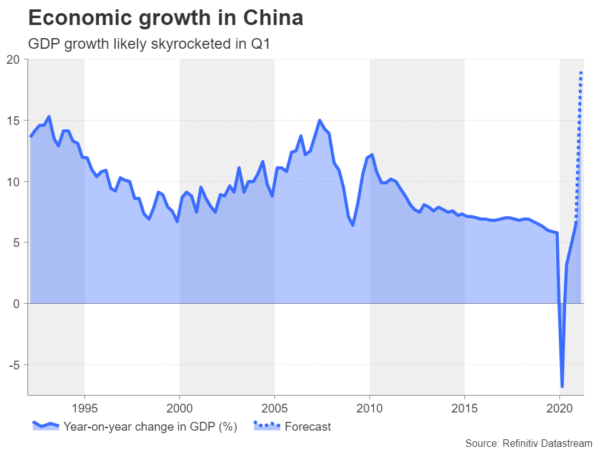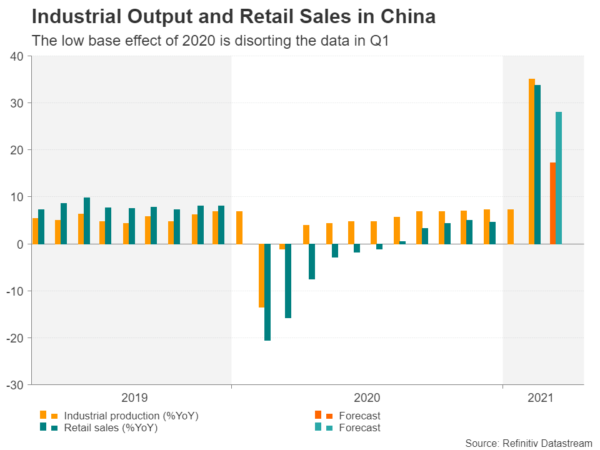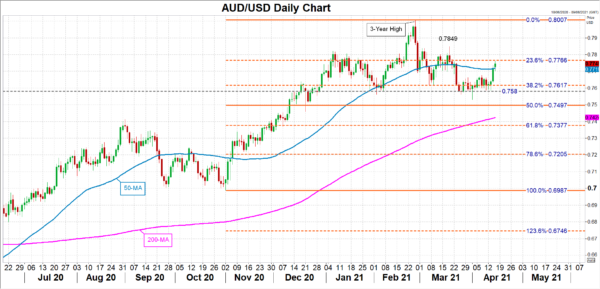China was the only major economy in 2020 that managed to grow for the full year, proving that it’s possible to leave the pandemic wreckage behind. The pace of the recovery is expected to have accelerated in the first quarter of 2021 and the country is on track for double-digit annual growth when it reports its GDP estimates on Friday (3:00 GMT). However, this growth surge is more likely down to the low base effect from Q1 2020 when China became the first country to be forced into lockdown to contain the spread of the coronavirus. Hence, investors might overlook phenomenal numbers and instead break down the GDP data to scrutinize the underlying strength of the economy.
First in, first out
China’s impressive recovery has become synonymous with the phrase ‘first in, first out’ as authorities’ tough and swift response to the initial outbreak of Covid-19, while devastating the economy in the first quarter, has ensured that much of the country has been able to avoid additional lockdowns. And since the second quarter, growth has outpaced all other industrialized nations. Booming exports have been the main driver of this enviable rebound.
Exports have now more than recovered from the Q1 slump and soared to an all-time high in December. Aside from the fact that the manufacturing sector globally has not had to adhere as strictly to lockdown rules as other sectors and there was some return to normalcy in the second half of 2020, Chinese manufacturers have enjoyed particularly strong demand for high-tech products, while the pandemic has boosted sales of medical equipment.
An export-led recovery
The remarkable turnaround in industrial activity from the depths of the virus crash likely lifted GDP growth to a record high in the first three months of 2021. Gross domestic product is forecast to have expanded by 19.0% in Q1 compared to the same period a year ago. However, on a quarterly basis, GDP growth is projected at 1.5%, which is closer to pre-pandemic levels and consistent with annualized growth of 6%.
That figure also happens to be comparable to the government’s modestly ambitious growth target of above 6%. But more importantly, it suggests the Q1 growth explosion is nothing more than a statistical blip and growth is almost certain to moderate in the rest of the year.
However, that is not the real concern as 6% growth would probably be sufficient to sustain risk appetite in the wider financial markets. The main worry is that when digging beneath the surface, things aren’t as rosy as they seem as the recovery has so far been uneven. Primarily, the boom in exports has not been matched by a similar rise in consumption.
Rebound in consumption is lagging
Although domestic consumption has been recovering steadily, it remains subdued, with households still wary amid the ongoing pandemic. The opposing trends in consumer and producer prices underlines the uneven performance. China’s annual CPI rate has only just stabilized and stood at 0.4% in March, but producer prices jumped by 4.4% to a near three-year high. The government had been struggling to raise personal consumption as a percentage of GDP even before the pandemic and the challenge has become even greater now.
Retail sales were up just 4.6% y/y in December before the distortion of the Lunar New Year and last year’s low base effect pushed them up to 33.8% in January/February. The forecast for March is 28.0%. Industrial production also got a transitory boost, surging to 35.1% y/y. It is expected to have eased to 17.2% in March.
Aussie looks to the China data to overcome key resistance
Any surprise uptick in the March readings would be seen as a positive sign that the recovery pace is not slowing. But the April numbers will be more telling about the broader trend, thus, market reaction to the GDP and March figures might be muted.
The Australian dollar is likely to see the biggest response to the data as Australia’s own recovery is dependent on healthy Chinese demand for commodities. The aussie is currently testing the 23.6% Fibonacci retracement of the November-February upleg at $0.7766. Upbeat Chinese indicators could propel the currency above this major resistance level and towards the March top of $0.7849.
To the downside, disappointing growth figures could push the aussie back below its 50-day moving average and towards the frequently visited support zone around $0.7580. A steeper decline would bring the 50% Fibonacci of $0.7497 into range.

















